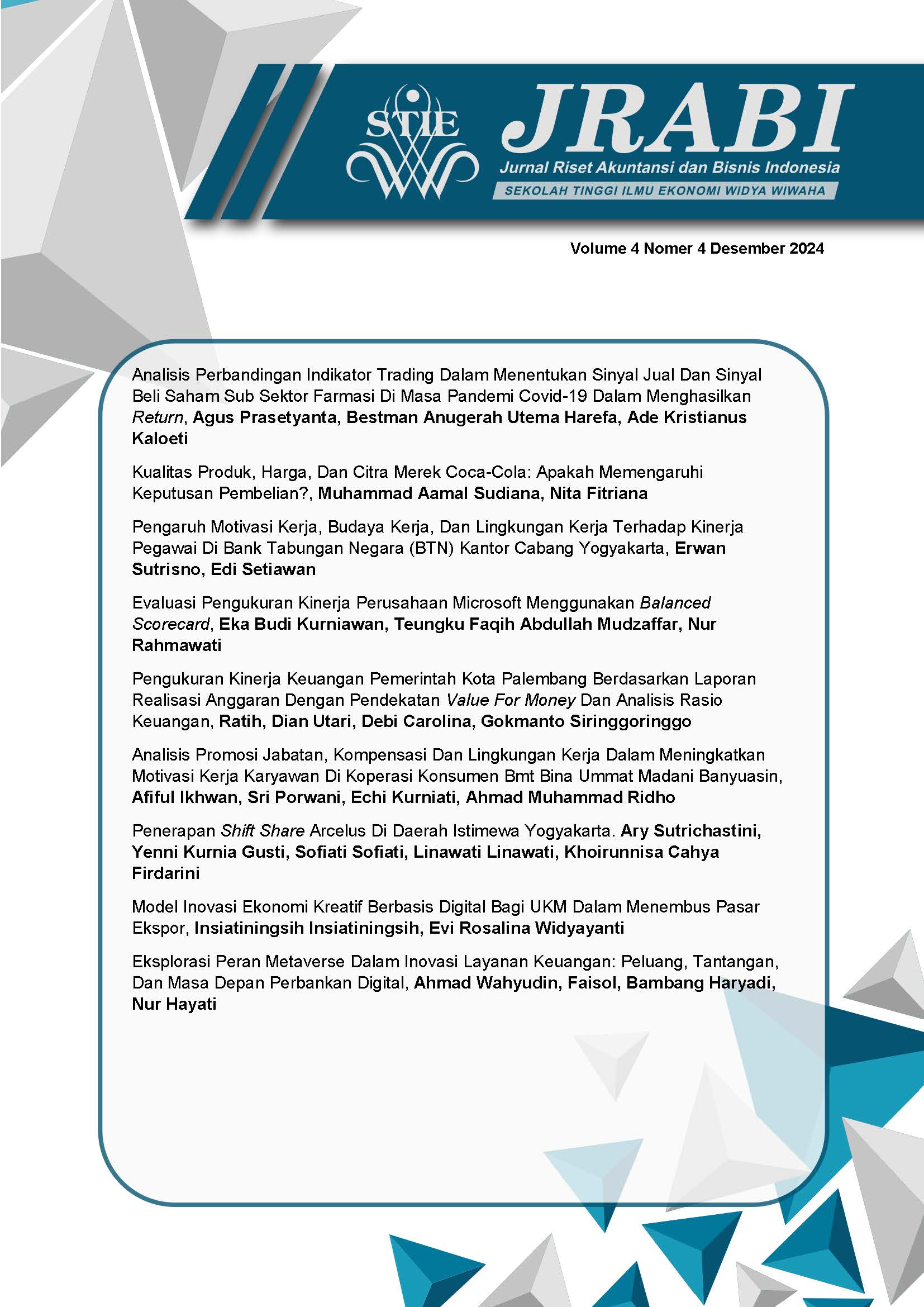PENGUKURAN KINERJA KEUANGAN PEMERINTAH KOTA PALEMBANG BERDASARKAN LAPORAN REALISASI ANGGARAN DENGAN PENDEKATAN VALUE FOR MONEY DAN ANALISIS RASIO KEUANGAN
DOI:
https://doi.org/10.32477/jrabi.v4i4.1087Keywords:
financial performance, budget realization reports, value for money, financial ratio.Abstract
In order to realize government goals, it is necessary to measure performance to evaluate whether operations are being carried out successfully or unsuccessfully in line with the aims and objectives of the government. Examining the description and financial performance of the Palembang City Government's budget realization report is the goal of this study, as determined by financial ratios and the value for money method in 2019–2023. The method of analysis in this research uses quantitative descriptive method. Researchers collected data using literature review and documentation methods. Tools to analyze financial performance using the value for money method, specifically in terms of effectiveness, efficiency, and economics, while the financial ratio approach is in terms Regarding the level of decentralization in finance, the degree of reliance on local funding, the effectiveness of PAD and the ratio of capital expenditure to the Budget Realization Report. The results of the Palembang City Government have provided information on budget realization reports openly and honestly to the public, seen from The economic approach of value for money in 2019-2021 is quite economical, while in 2022-2023 is less economical, is classified according to its efficiency as being less effective and efficient in 2019–2021 is categorized as quite effective, while in 2022-2023 is categorized as effective. With the financial ratio approach, the Palembang City Government is determined using the level of fiscal decentralization in 2019-2020 which is categorized as moderate, in 2021-2023 which is categorized as quite good, Regarding the Palembang City Government's level of regional financial reliance in 2019–2023, it is classified as moderate, Regarding the efficacy of PAD in 2019–2020, which is deemed ineffective, in 2021 which is less effective, in 2022 which is very effective, in 2023 which is considered effective. And calculated by the ratio of capital expenditure illustrates instability with an average of 21.68%.
References
Ariyani, L. D., Wafirotin, K. Z., & Wijayanti, I. (2022). Analisis kinerja keuangan ditinjau dari realisasi anggaran belanja tingkat ekonomis, efektivitas, serta efisiensi pada BAPPEDA LITBANG Ponorogo. MAMEN (Jurnal Manajemen), 1(3), 417–431. https://doi.org/10.55123/mamen.v1i3.712
Bastian. (2006). Pengantar Akuntansi Sektor Publik. Jakarta: Erlangga.
BPK. (2010). Peraturan Pemerintah Republik Indonesia Nomor 71 Tahun 2010 Tentang Standar Akuntansi Pemerintah (SAP). Jakarta: BPK RI https://Doi.Org/10.1017/CBO9781107415324.004
Dhoe, M. S., Suharto, R. S. B., & Seliamang, Y. M. (2019). Analisis value for money dalam menilai kinerja keuangan pada Badan Keuangan Daerah Kota Kupang. Jurnal Akuntansi, Keuangan dan Audit, 4(1), 7–13.
Mahmudi. (2005). Manajemen Kinerja Sektor Publik. Yogyakarta: UPP AMP YKPN.
Mahmudi. (2019). Analisis Laporan Keuangan Pemerintah Daerah (Edisi Keenam). Yogyakarta: UPP STIM YKPN.
Mahsun, M. (2009). Pengukuran Kinerja Sektor Publik (Edisi Ketiga). Yogyakarta: BPFE. ISBN 978-979-503-493-6.
Mahsun, M. (2015). Akuntansi Sektor Publik (Edisi Ketiga). Yogyakarta: BPFE. ISBN 979-503-492-8.
Mahsun, M. (2016). Pengukuran Kinerja Keuangan (Edisi Ketiga). Yogyakarta: UII Press. ISBN 978-602-73756-3.
Mardiasmo. (2018). Akuntansi Sektor Publik. Jakarta: Salemba Empat. ISBN 978-602-440-673-4.
Nordiawan, Deddi, Dan A. H. (2010). Akuntansi Sektor Publik (Edisi 2). Jakarta: Salemba Empat.
Rahmi, N., Rahayu, S., & Jumaili, S. (2023). Analysis of Village Government Financial Performance Using the Value for Money Method in Pamenang District, Merangin Regency. Indonesian Journal of Economic & Management Sciences, 1(3), 377–388. https://doi.org/10.55927/ijems.v1i3.4740
Sanger, G. W., Manossoh, H., Claudia, W. M., & Bahu, J. K. (2023). Evaluasi Kinerja Keuangan Dengan Metode Value for Money Pada Badan Keuangan dan Aset Daerah Kota Manado. Jurnal LPPM Bidang EkoSosBudKum, 6(2), 1193–1202. https://doi.org/10.55927/lppmekososbudkum.v6i2.45919
Sanjaya, D. H., & Priyadi, M. P. (N.D.). Analisis Value for Money dalam Pengukuran Kinerja. Jurnal Ilmu dan Pendidikan. Doi: 10.58192/Populer.V2i3.1195
Simamora, H. (2004). Akuntansi Manajemen (Edisi 3). Jakarta: Salemba Empat.
Sugiono. (2013). Metode Penelitian Kualitatif dan Kuantitatif. Bandung: CV. Alfabeta.
Wulandari, D., & Rosalin, F. (2017). Analisis Kinerja Keuangan atas Pelaksanaan Anggaran Pendapatan dan Belanja dengan Penerapan Value for Money pada UPTD Pengujian Kendaraan Bermotor Kota Palembang. JEMBATAN: Jurnal Ekonomi, Manajemen, Bisnis, Auditing, dan Akuntansi, 4(2), 35–60. https://doi.org/10.29240/jembatan.v4i2.43







